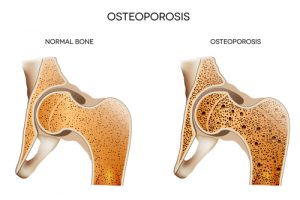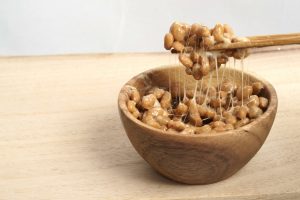Every 6 minutes someone breaks a bone due to bone depletion
Like arthritis, osteoporosis has become a real public disease. Over the age of 50, one in three women and one in seven men are affected by this condition. This is a creeping disease that may start very gradually from the 40th year of life. It is therefore important to take measures around this age, or rather before, to reduce the risk of osteoporosis.
Two percent less bone tissue per year
Upon ageing, bones lose their solidity. Although a large part of the bones consist of non-organic material, and many people consider it non-living, this is a very dynamic tissue. It is continuously broken down and rebuilt. After the 30th year of life, bone breakdown is gradually greater than bone production. This results in the decrease of bone mass by about 2 percent per year from the 40th year of life. Meanwhile, you are not aware that your bones become more brittle. This is only noticed when you break a bone at a higher age in a fall. In most cases it is a hip, wrist or spine. Did you know that everybody in the Netherlands breaks a bone because of osteoporosis?
Cause osteoporosis in women and men
In women, menopause is the most common cause of osteoporosis. The ovaries then stop producing estrogen. This female sex hormone inhibits bone mineral degradation. This protective effect decreases when there is less estrogen present in the body. As a result, the bone mass will decrease. The bones become brittle and may therefore break more easily in case of fall injuries.
On average, men get bone loss 10 years later than women on average. The reason is that men have more bone tissue. The bone loss of two percent per year results into thinner and brighter bones later in men. Also in this case, a hormone plays an important role in the development of osteoporosis. Upon aging, the production of testosterone decreases. This male sex hormone is actively involved in the construction and maintenance of bone tissue. As soon as less testosterone is produced, bone mass decreases.
Calcium from the sea
What can you do to prevent osteoporosis or stop decalcification of your bones?
At least you have to ensure proper supply of enough calcium to your bones. Your body contains about one and a half kilo of this mineral. About 99% of it is found in your bones. It is very important that you choose a well-absorbable form of calcium. For instance, these are found in the red algae that live in the clean waters around the coast of Iceland. The official name Lithothamnion calcareum already gives a hint in this direction. This means ‘plant covered with calcium’.The red algae appear to be particularly rich in calcium and other trace elements, such as magnesium. The great benefit of these minerals from the sea is that they can be absorbed faster and more completely by your body – and therefore by your bones. As a result, bone structure is improved and bone density strengthened. In addition, recent scientific research has shown that red algae inhibit the action of COX-2 in the joints. This enzyme plays a role in the onset of inflammation in osteoarthritic joints.
Vitamin D
Furthermore, calcium must always be taken together with vitamin D3. Many osteoporosis patients have a vitamin D deficiency. This nutrient plays an important role in the absorption of calcium in the body. A good nutritional supplement for strong bones, in any event, contains Calcium derived from Red Algae as well as Vitamin D3.
Vitamin K2: indispensable for strong bones
Scientific evidence has now been found that vitamin K also has an essential contribution to the strengthening of the bones.
This nutrient stimulates the activity of osteocalcine. This protein is needed to actually build calcium into the bones. Without vitamin K there is a risk that the intake of Calcium will remain in the blood. In the veins, excess calcium can cause arteriosclerosis. The use of Vitamin K in a calcium supplement is therefore very important. Our food contains almost exclusively vitamin K1. However, it has been shown that osteocalcine only works well if there is enough vitamin K2. Vitamin K2 is taken up considerably better than vitamin K1. This nutrient is present in some foods – such as natto (fermented soybeans). When we do not eat enough of this, vitamin K2 can be taken as a supplement. The best form of vitamin K2 is K2-MK7 (menaquinone-7). It has been proven that it actually helps to reduce bone mineral levels and makes the bones stronger. In addition, vitamin K2-MK7 is a proven important factor for the heart and blood vessels. It prevents arteriosclerosis, keeps the blood vessels elastic and reduces the general risk of coronary heart disease.
Vitamin K2 and certain anticoagulants
For people who use anticoagulants of the oumarin derivatives type, vitamin K2 has a disadvantage: vitamin K2 may not be used together with acenocoumarol, fenprocoumon and warfarin. The action of coumarin derivatives is based on inhibiting vitamin K2. Using extra vitamin K2 next to these vitamin K2 inhibitors is therefore not a good idea. With other anticoagulants that work differently (and thus are not coumarin derivatives), vitamin K2 may be used without risk. If you want to use Vitamin K2, and use a coumarin derivative, consult your doctor or pharmacist first.
Magnesium, Vitamin B2, B3 and B6
Finally, we would like to mention a number of nutrients that play a role in maintaining strong bones. Magnesium is one of the most important minerals for bone building and also promotes the incorporation of calcium into the bones. Magnesium is also good for the brain and your heart, gives more energy and has a muscle relaxant effect. A magnesium shortage can cause stress and tense muscles. The best absorbable form is bioactive magnesium citrate. Vitamin B2, Vitamin B3 and Vitamin B6 also contribute indirectly to maintaining strong bones. These vitamins increase the energy level of your body. And moving is good for your bones. Walking, cycling, gardening, rowing or golfing makes your bones heavier. This makes them firmer.
How to choose a good bone building supplement
It is wise to study the label carefully before you buy a calcium supplement. Importantly, this product should contain at least Calcium from Red Algae, Vitamin K2-MK7 and Vitamin D3. It is also important that the supplement is liquid. The bone-building and enhancing vitamins and minerals are then better and more fully absorbed. There are capsules at the drugstore, pharmacy and reform store that contain these high-quality ingredients. These capsules also contain the supported ingredients magnesium citrate, vitamin B2, vitamin B3 and vitamin B6. These supplements provide a complete solution for anyone who wants to reduce the risk of osteoporosis. If you use anti-coagulants (blood thinners): Note if it is a coumarin derivative or not, because then you may not use vitamin K2. Always consult your doctor or pharmacist if you have any doubts about the combination with your other medication.

Share this page
Tweet

Download for free the booklet ‘Moving without pain’ with a retail value of $6.75 / £4.95.
Any questions? Please feel free to contact us. Contact us.








